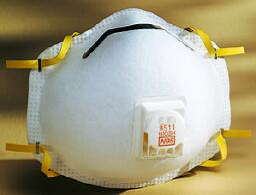How to Use an N95 Mask
- How to Use an N95 Mask is available in PDF.
This webpage provides advice for using a disposable N95 mask.. A disposable N95 mask (respirator) is a safety device that covers the nose and mouth and helps protect the wearer from breathing in some hazardous substances. An N95 mask protects you from breathing in small particles in the air such as dust and mold. It is designed to filter out at least 95% of the dust and mold in the air.
What to Get

You should only use an N95 mask that is certified by the National Institute for Occupational Safety and Health (NIOSH). Look for the NIOSH logo and the test and certification (TC) approval number on the mask or packaging. Masks that are not certified by NIOSH may not provide adequate protection to you. Masks are typically available from your local hardware stores or home improvement centers.
Use an N95 mask even if you cannot see the particles because they may be too small to see. N95 masks do NOT protect you against chemical vapors, gases, carbon monoxide, gasoline, asbestos, lead or low oxygen environments.
Who Should Check with a Healthcare Provider First
If you have a pre-existing medical condition, wearing a mask may make breathing more difficult because you must pull air through the mask as you inhale. People with known or suspected breathing problems, emphysema, chronic obstructive pulmonary disease (COPD), asthma, or cardio/pulmonary problems should consult with their physician before using one. If at any time during use of the mask you experience headache, nausea, dizziness or have difficulty breathing, immediately leave the area, remove the mask, get fresh air, and seek medical attention if needed.
How to Wear the N95 Mask
Always read and follow the manufacturer's directions when using an N95 mask. It must cover both the nose and mouth to keep you from breathing in mold and dust. If it does not have a snug fit, it will not work properly. Correct fit of the mask requires contact with smooth skin. It will not work properly for people with beards or facial hair. Even one-day beard growth has been shown to let air leak in. Always use both straps on the mask to hold it in place to keep air from leaking around it.
How to Make Sure the Mask Fits
Do a user seal check, including both positive and negative pressure checks, to verify that you have correctly put on the mask and adjusted it to fit properly.
Negative pressure check
Place both hands completely over the mask and inhale sharply. Be careful not to disturb the position of the mask. The mask should pull into your face. If air leaks around your face or eyes, adjust the nosepiece and straps and repeat the positive pressure check.
Positive pressure check
Put your hands over the mask and breathe out sharply. If your mask has an exhalation valve (like the one pictured above) be sure to cover the exhalation valve when you exhale. No air should leak out of the mask if it fits properly. If air leaks out, re-adjust the nosepiece and straps and repeat the negative pressure check.
When to Throw Out the N95 Mask
As the N95 mask gets clogged, it becomes more difficult to breathe. When this occurs, throw it out and use a new one. Discard the mask if it is wet or dirty on the inside, if it is deformed, or if the filter is torn. A deformed mask may not fit properly. An N95 mask cannot be cleaned or disinfected.
Additional Information
For additional information on N95 masks or other types of masks, you can contact the Bureau of Occupational Health and Injury Prevention at (518) 402-7900 or (800) 458-1158. Also note: if masks are required for your job, your employer must implement a respiratory protection program that meets Occupational Safety and Health Administration (OSHA) or Public Employee Safety and Health (PESH) standards.